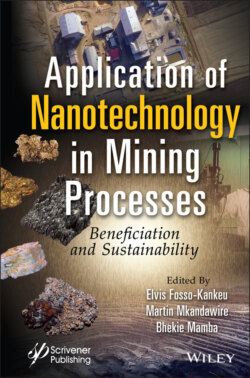Читать книгу Application of Nanotechnology in Mining Processes - Группа авторов - Страница 15
1.2.2 Rare-Earth Elements and Their Importance
ОглавлениеRare earth elements consist of the 15 lanthanide elements including yttrium (Y) and scandium (Sc) on the periodic table. These elements exhibit similarities in geochemical behavior because of their identical stable trivalent oxidation state (except Ce and Eu), systematic decrease in ionic radius and increasing atomic number [24]. Mineral deposits of REE typically occur in low concentrations as oxides or carbonates in a broad array of geologic formations in very few countries, and over 90% of REE production occurs in China [25]. This near-monopoly has created a conceivable handicap for other countries where REEs are not readily produced [10]. The demand for these REEs has increased tremendously over the years due to their extensive application in several scientific advancements (Table 1.3) owing to their unique magnetic, phosphorescent, and catalytic properties [26]. The extraction of these elements from their conventional ores is energy-intensive and alone is insufficient to satisfy the rising demand in the foreseeable future due to their strategic importance in modern technology [27, 28]. Consequently, it has prompted researchers, national governments, and private entities to develop possible techniques for recovering these elements from unconventional sources, such as AMD, to meet the rising demand. In the United States, a significant concentration of REE was found in precipitates formed during acid mine drainage treatment from coal tailings [10]. In Brazil, acid water generated in a uranium mine in the state of Minas Gerais was found to contain a total concentration of 126 ppm of REE significantly higher than acid waters generated from different mines worldwide [29]. Also, in the Guizhou province in southwestern China, the Xingren coalfield mine is reported to contain REE concentrations varying between 0.1 and 0.9 ppm [30]. Although the recovery of rare earth metals from AMD remains a great challenge as it is several orders of magnitude lower in this product than the conventional REE ores, it can be recovered using a low-cost nano-adsorbent if concentrated out of the liquid solution during the neutralization processes [31]. The emergence of nanotechnology has contributed tremendously to economic prosperity by providing solutions to some challenges facing modern-day technology [32]. In this chapter, a state-of-the-art technique will be presented using modified magnetic dendrimer nanoparticles to effectively recover REE from AMD after alkaline treatment. First, the generation of AMD and its environmental effect are highlighted, and then in the following sections the shortcomings of various remediation methods for AMD as background motivation for this method design are discussed.
